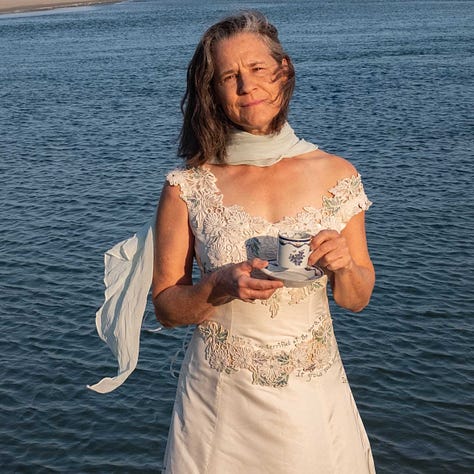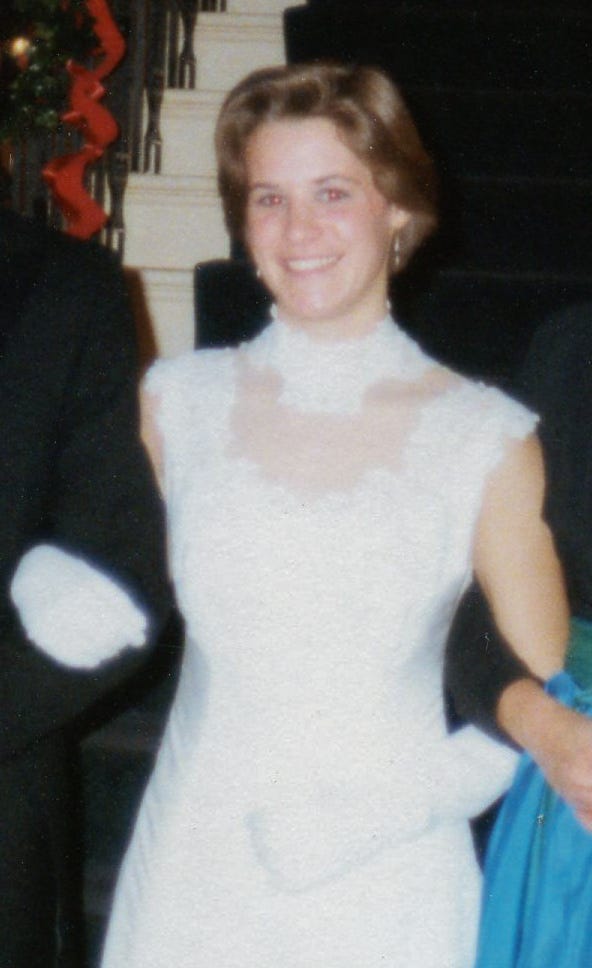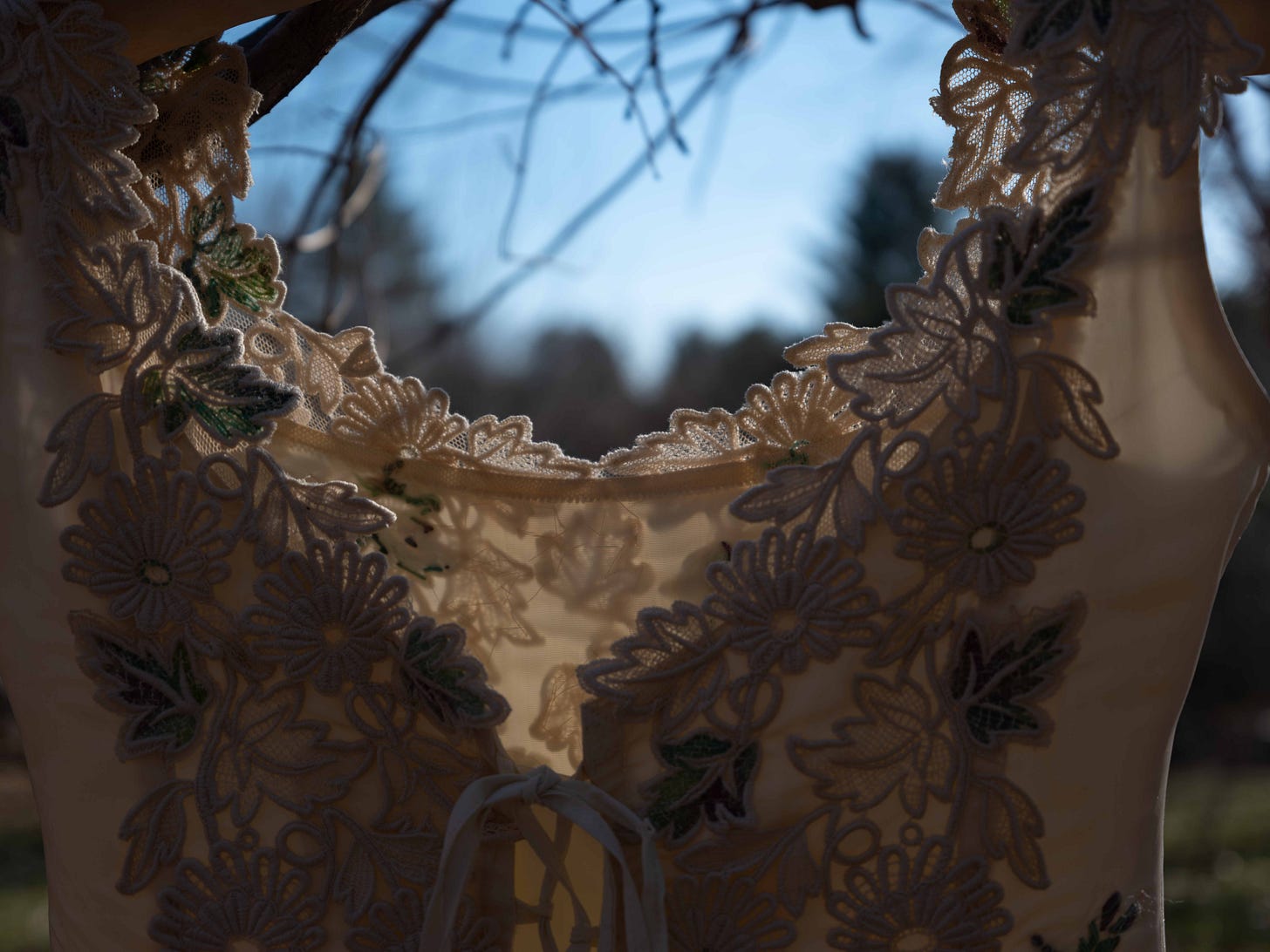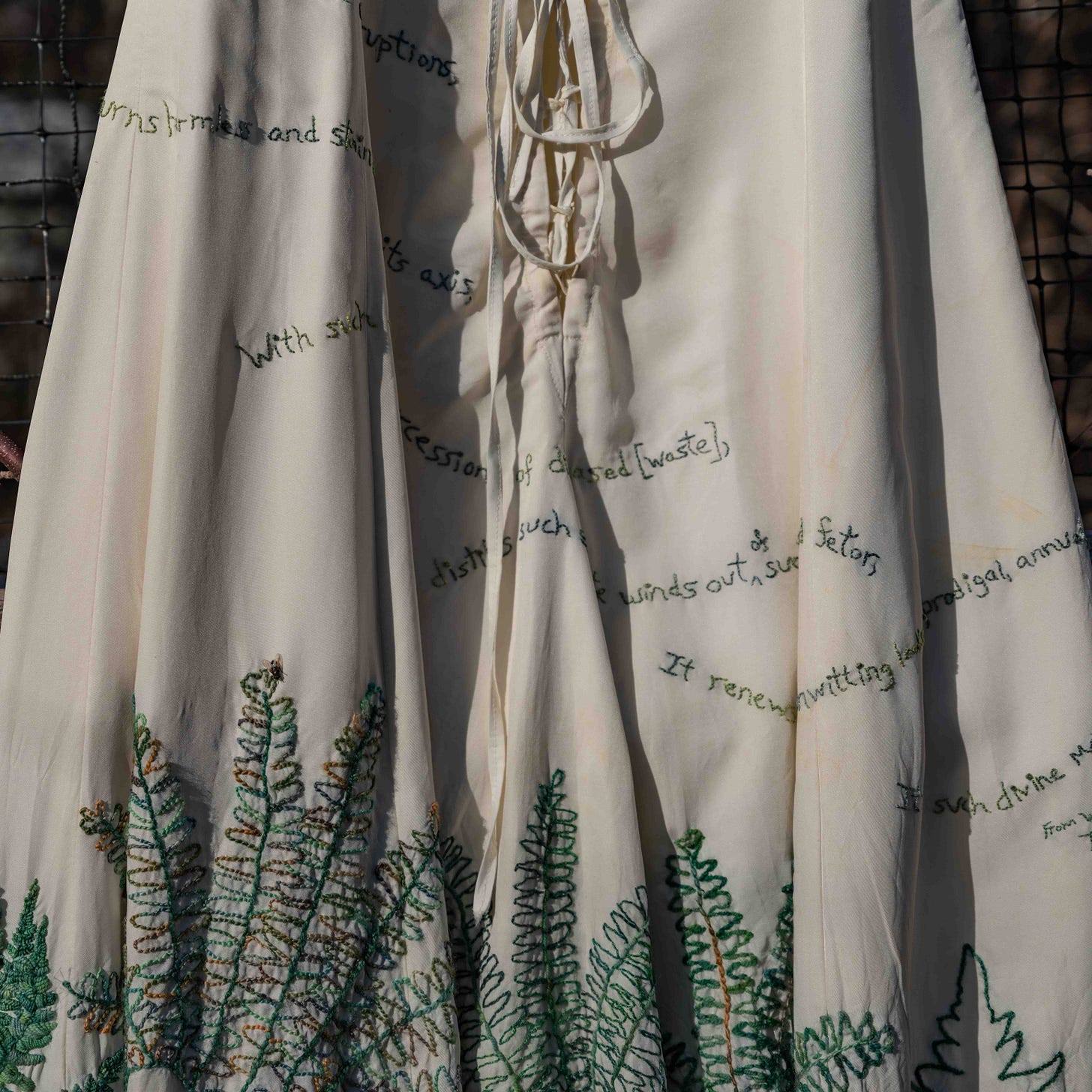Dear Readers,
Once there was a dress worn by a sister in distress.
The younger admired and wanted to emulate her elder, but time passed, and the family moved on, so she wore the hand-me-down and went to a different dance instead.1
In the end, neither one had a good time and wished they’d never been surrounded by such fuss in the first place.
But the younger loved the dress anyway because it was a physical connection to her sister who had bravely moved thousands of miles away.
She kept it stored in its box for decades, until, one day, it beckoned, a blank palette inviting re-examination.
“You longed to belong,” it said.
My sister and I did not know how to be the social princesses my grandmother had once been.2 We were born into her kind of world, but were most definitely not of it.
We lived on a long dirt road miles from social clubs, made compost in an organic vegetable garden and swam in ponds.
“You thought I was the ticket.”
What was I thinking, decades ago, when I longed for such things?
Perhaps it was because Gram, the one who Charlestoned in a glorious pink gown during her own debut, thought this dress was just right, this process a good thing.3
But while Gram’s gown had invited me to dance and laugh, this pit stained and wine smudged wedding-dress like outfit terrified me. It had been 35 years. I was not the person I once was. And there was something mis-placed about the preciousness of it all.
At first, I kept it at arms length, enjoying how the light hit the silk, how the lace brought out the textural nuances in the rock, and how the wine stain revealed individual satin fibers.
I wondered who made the dress and if they were paid a living wage.
I wondered what chemicals had been used to ensure the lace and silk were perfect.
And after a few photo shoots, it spoke again:
“Don’t be afraid,” it said. “Move on.”
So I put on the dress and wore it around.4
“What do you want from me?”
“To heal, together.”
So we became companions, trying to figure out that underlying terror.
“Color. I need color.”
So I started to embroider…which, at the time, seemed radical.
“I want to breathe.” And off came the lace and ‘choker.’
Let’s celebrate the hip, and all that makes a woman, a woman.
The dress started to feel like a poem, that one by Walt Whitman about compost.5
“Now I am terrified at the Earth, it is that calm and patient,
It grows such sweet things out of such corruptions,
I experiment with how the words from the final stanza might flow…
It turns harmless and stainless on its axis, with such endless successions of diseas'd [waste],…”
…and notice how the materials look and feel in different light.
“It distills such exquisite winds out of such infused fetor,
It renews with such unwitting looks its prodigal, annual, sumptuous crops,”
I shortened the hem, so one could, in theory, do the Charleston…
“It gives such divine materials…, and accepts such leavings from [us all]. “6
Ferns appeared.
Slowly, joy emerged from pain, even when a red threaded fern needed green yarn instead.
It took longer than I thought to complete…just as it takes longer to cultivate new habits and ways of being.
Since I had composted my Harvard and University of Virginia Diplomas back in 2018, I had been exploring questions about privilege, power and my complicity with injustices of all kinds.7
Compost was my muse and metaphor. Sometimes we have to toss ‘it’ all into a pile and let ‘it’ simmer and ruminate for a while, letting time and patience reign, accepting that reality is not always pretty, but the process itself is beautiful.
This re-imagined cotillion dress, it seems, was a proxy for my own desired personal transformation. It felt that in the act of its re-creation, I composted parts of myself.
But while I had stitched my guilt, grief and a deep longing for equilibrium into its fibers,
“[The earth] gives such divine materials…, and accepts such leavings from [us all],”
I still didn’t feel the “exquisite winds” or any of the sumptuousness Whitman described.
Who knew? It takes a whole lot more than re-imagining a dress or composting a few diplomas to undo the impacts of privilege and power.
This became particularly obvious when I participated in a Cross Class Dialogue workshop in January and February just before Covid. It was terrifying to realize the depths of my engrained entitlement as well as the possibility for awakening to all that I might have known intellectually, but did not understand in my heart.8
My collaboration with this dress and all that it represented was far from complete.



So in the fall of 2020, we got back together again, first on the coast of Maine and then in the Vermont woods.
I was defiant and amused as we experimented together until, one day, I was done playing dress up, exhausted, in fact, by processing the all of it.
As happens with me, an object served as companion and catalyst.
It seems that to cross barriers and enter new ways of being, I needed to not just follow the light, but to let the light in, as well.
So I put the dress back on its mannequin until after my mother died, after I’d moved into a studio, and after I’d had some time to process some of my grief, not just for my mother, but for all that she represented.
There are endless ways to re-imagine ourselves and the communities we inhabit. For me, it has always helped to have a companion, whether that be a person, place or thing.
First it was Gram’s gown, then it was my sister’s and my ‘cotillion’ dress, and then it was an entire wardrobe of vintage outfits, of which this newly embroidered piece of silk was just one.
At some point during that final photo shoot the wind blew my sister’s and my dress onto the ground. Rumpled among the leaves, it returned to earth, not far from my decomposing garden library of reference books, where it, and we, belong.9
And that was that.
I put the old clothes into to a vintage suitcase and I started 13 Tons of Love.
Where the contents of this suitcase will travel next remains a mystery.
There is terror when in conversation with the unknown…and, thanks to the passage of time, there is also forgiveness, gratitude and grace.
If it were not for 13 Tons of Love, I would never have put these images and these ideas together, mush less shared them in such a public way. Thank you.
The elder sister now tells stories with yarn and makes cool stuff out of coffee filters and milkweed fibers10; the younger makes meaning from compost and other stuff; the distressed dress they both once wore is, like them, transformed and transforming and very much awake.
Thank you for sharing your time and this space with me.
With cheers and gratitude for you being you,
Lyn
Please share any responses you might have to this ‘goodbye story.’ Remember to click on the link below and not hit reply, because if you do, I’m afraid I’ll never see what you’ve written!
And if you know someone for whom 13 Tons of Love might be of interest, please share!
The elder attended the Baltimore Cotillion in 1978; The younger attended The Junior Assemblies in New York City in 1984.
To learn more about my grandmother, check out last week’s missive:
Gram's Dress, A Goodbye Story
Hello Friends and a big welcome to all New Subscribers! Last week’s piece, Dwelling in Loss & Light, drew more attention than any previous post, except for the one I wrote last fall about composting in New York City. Thank you for your continuing interest!
Gram’s Dress, A Goodbye Story.
Our Grandmother was very much involved in my sister’s ‘debut’ in Baltimore, a city hundreds of miles from our home near New York City. By the time I was old enough, my grandfather had died, my grandmother remarried and moved, and everyone was so traumatized by my sister’s anger that they never considered that I might actually be interested. Only when a college friend invited me to join her, did I have the opportunity. At the time I was a freshman and eager to ‘belong.’ But it’s hard to belong if you are not fully ‘of’ a culture.
At around this time, I had met an art-therapist who invited me to actually put the dress back on, even if it didn’t still fit. I am so grateful for that invitation.
As part of Leaves of Grass, Walt Whitman wrote This Compost about the earth’s power for renewal after the Civil War. In the final stanza I embroidered onto the dress, I altered some of the original words to make it feel more relevant to the 21st century.
I first learned about this poem when visiting a cousin in Brooklyn, NY back in 2017 when I first began to seriously cultivate my compost portfolio. Knowing that Whitman had written something about compost more than 150 years earlier, added validity to my own belief in compost’s power to explain and inspire.
That said, over time, my own words and experiences felt more real to me than his. I liked having his words on the dress, though, as by putting them there, I could move on from them and embrace more fully my own narrative. A small ‘goodbye story’ moment.
In 2018 I composted my Harvard and University of Virginia diplomas. This post gives more details:
The Origin Story, Part 4: Meaning
Happy Fall! This truly is my favorite time of year. The colors and spirit of the changing seasons make me feel alive again after summer’s odd heat-induced dormancy.
Origin Story, Part 4: Meaning
While many Cross-Class Dialogue Circles happen in person, mine was online. While this offered me a chance to learn about people’s experiences from around the country, it also remained a bit at arms length for me, like the way I’d first documented the dress. It took me months to process the experience itself, but it was uncanny how the conversations provided a foundation for my capacity to process for all that unfolded in 2020 and that continues to unfold today.
For more, check out Composting & Composing A Life.
To learn more about this mysterious woman, check out The Gusset. I am in awe of my sister, Sarah Swett, and am grateful that we shared that dress decades ago. It has played such an interesting role in each of our lives in very different ways.































I found my way to your amazing sister through my love of fibery things, and you showed up linked to her blog one day. Your family backstories are intriguing; I have two younger sisters and it occurs to me how different was their experience in the family.... And the dress! your alterations and embroidery were quite wonderful, your letting it go back to the earth disconcerting but somehow appropriate.
I love the alternations to the dress and your reflections on its history and possible future. I have 4 sisters and really appreciate our unique relationships, our similarities and our differences... and our shared clothing over many years!